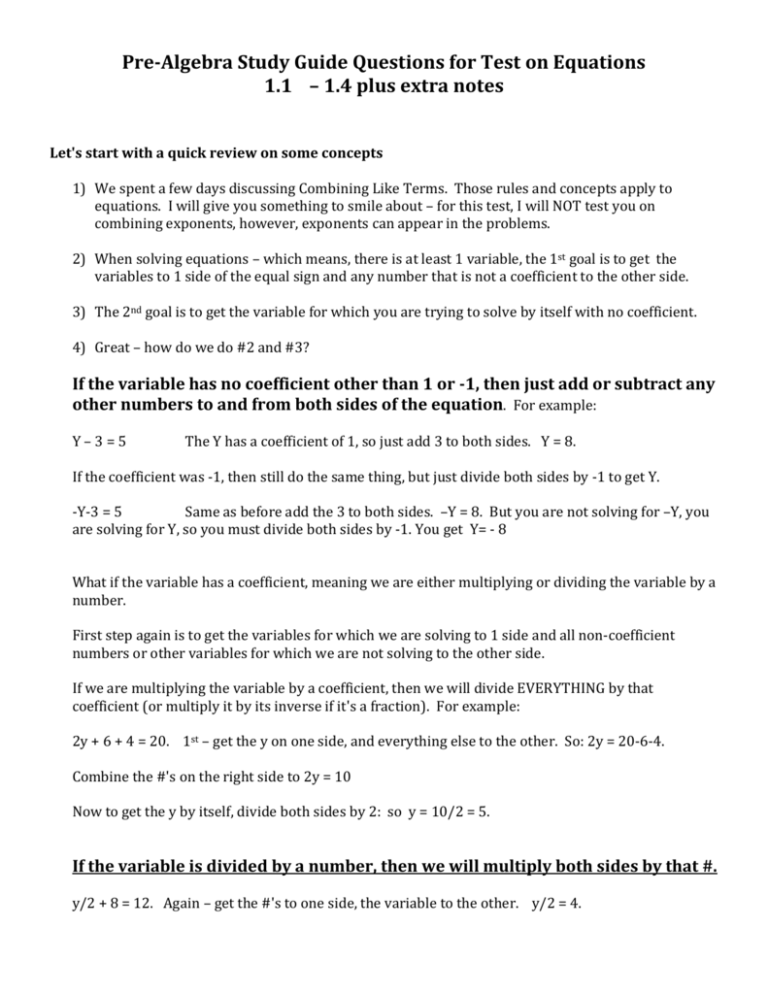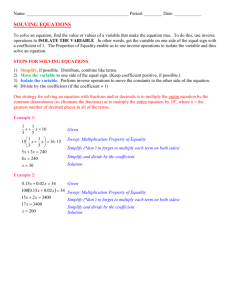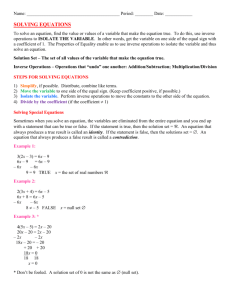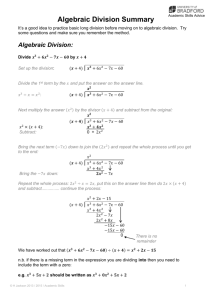10/15/15 PreAlg Extra Notes Study Guide for Equations 1.1
advertisement

Pre-Algebra Study Guide Questions for Test on Equations 1.1 – 1.4 plus extra notes Let's start with a quick review on some concepts 1) We spent a few days discussing Combining Like Terms. Those rules and concepts apply to equations. I will give you something to smile about – for this test, I will NOT test you on combining exponents, however, exponents can appear in the problems. 2) When solving equations – which means, there is at least 1 variable, the 1st goal is to get the variables to 1 side of the equal sign and any number that is not a coefficient to the other side. 3) The 2nd goal is to get the variable for which you are trying to solve by itself with no coefficient. 4) Great – how do we do #2 and #3? If the variable has no coefficient other than 1 or -1, then just add or subtract any other numbers to and from both sides of the equation. For example: Y–3=5 The Y has a coefficient of 1, so just add 3 to both sides. Y = 8. If the coefficient was -1, then still do the same thing, but just divide both sides by -1 to get Y. -Y-3 = 5 Same as before add the 3 to both sides. –Y = 8. But you are not solving for –Y, you are solving for Y, so you must divide both sides by -1. You get Y= - 8 What if the variable has a coefficient, meaning we are either multiplying or dividing the variable by a number. First step again is to get the variables for which we are solving to 1 side and all non-coefficient numbers or other variables for which we are not solving to the other side. If we are multiplying the variable by a coefficient, then we will divide EVERYTHING by that coefficient (or multiply it by its inverse if it's a fraction). For example: 2y + 6 + 4 = 20. 1st – get the y on one side, and everything else to the other. So: 2y = 20-6-4. Combine the #'s on the right side to 2y = 10 Now to get the y by itself, divide both sides by 2: so y = 10/2 = 5. If the variable is divided by a number, then we will multiply both sides by that #. y/2 + 8 = 12. Again – get the #'s to one side, the variable to the other. y/2 = 4. Since y is being divided by 2, you have to multiply everything by 2. So y = 8 If the coefficient is being multiplied by a fraction, then multiply everything by the inverse of that fraction. 2 2 3 3 y + 4 = 6. Again – subtract both sides by 4 to get variable by itself. 3 y = 2. 6 Now multiply by 2 to get 1y = 2 = 3. 5) What was the deal with not using the distributive property when there is parenthesis? Do not get confused – it is perfectly ok to use distributive property when you see parenthesis. However if there is nothing else on the one side except for the coefficient and the parenthesis terms, then you can just divide everything by the coefficient. 2(3+x) = 10. You can either do the distributive and get 6+2x = 10. Which becomes 2x = 4, so x =2. or You can just divide by 2 from the beginning and get 3+x = 5; x=2. Even if there is another # on the same side as the parenthesis term, you can add or subtract that # from both sides 1st, and then just divide everything by the coefficient: 2(3+x) + 2 = 10 Subtract the 2 first to get 2(3+x) = 8. Then divide everything by 2 to get 3+x = 4. x=1. If you do distributive first you would get: 6+2x + 2 = 10. Then you would combine the numbers to get 2x+8 = 10. Subtract the 8 to get 2x = 2. X=1. It’s the same answer, just more steps. Remember correct order of operations: PEMDAS Finally, CHECK YOUR ANSWERS BY PLUGGING THEM BACK INTO THE EQUATION.







